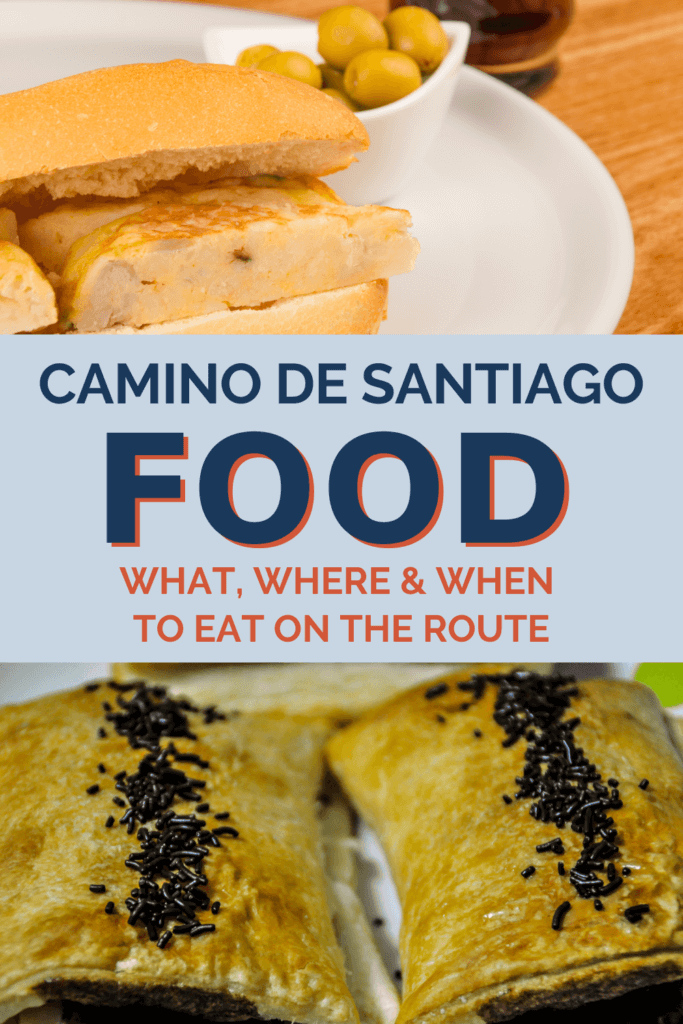Food on the Camino de Santiago: Cost, Pilgrim Meals, What & Where to Eat
What do you eat on the Camino de Santiago? Read to find out what to expect!
If you’re walking the Camino de Santiago, knowing what to expect when it comes to food is a subject you’ll want to dive into!
Fortunately, food is easy to find on most routes of the Camino de Santiago. To explain, there is no shortage of cafés, bars, grocery stores, and restaurants right on the path.
When it comes to what to purchase, eating along the Camino de Santiago is pretty straightfoward. In fact, some pilgrims complain about the monotony of Spanish food.
Having lived in Spain in my mid-20’s, I knew that the country had a reputation for simple food. So, when I walked the Camino de Santiago a decade later, I didn’t complain. I was grateful for the simplicity of my plate—yet another joy of the Camino journey.
In this post, I’ll share with you what it’s like to eat on the Camino de Santiago, average food costs, and some tasty dishes to try so you’re fully aware of what to expect.
Food On the Camino de Santiago: What to Expect
Let’s dive into pilgrim meals on the Camino de Santiago pilgrimage, broken down by meal.
1. Breakfast on the Camino
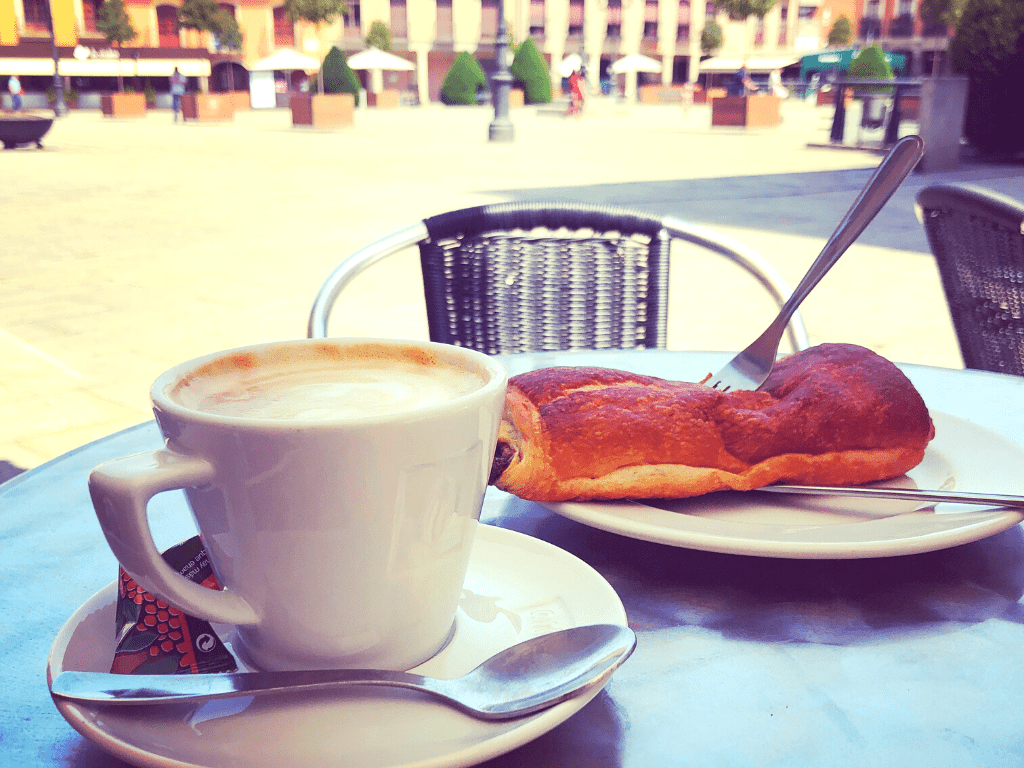
When it comes to food on the Camino, a good breakfast at the start of each day of the walk is essential.
That being said, hearty breakfasts don’t really exist on the Camino! Instead, breakfast on the Camino is pretty basic!
Here’s what to expect for at breakfast time along the Camino.
When you wake up, cafés and bars are typically closed. This is especially true for those who awake at dawn to beat the heat in the summer if that’s your preferred season to walk the Camino.
If you need a coffee first thing in the morning to get you going, plan to go without. Instead, grab your pack, and walk a few miles/kilometers.
At this point, enough time will have passed and you’ll find an open bar or café (7 or 8 am).
Here’s what you’ll typically find on the breakfast menu:
- Tostadas — Toast with toppings that vary from olive oil or jam to tomato or cold cuts (mainly Spanish ham).
- Tortilla de patata — This is Spain’s famous omelet of eggs, potatoes, olive oil, and onions.
- Pastries — Choices range from napolitanas de chocolate (akin to a chocolate croissant) and empanadas de atún (savory tuna pastries) to Santiago cake (almond cake).
- Drinks — Coffee, tea, and freshly-squeezed orange juice.
Note that not all bars serve food. In this case, stop for a drink and a rest break. There will be another bar for food later on.
Typical cost for breakfast on the Camino: $3-4 (€3-4)
Around 10 am, plan to enjoy what pilgrims call Spain’s “second breakfast” ( known as almuerzo). Certainly, you’ll be ready to rest again and very possibly hungry after all that walking! Rest your feet, drink another coffee, and eat some toast or tortilla de patata—whatever you didn’t have at your first stop.
2. Lunch on the Camino
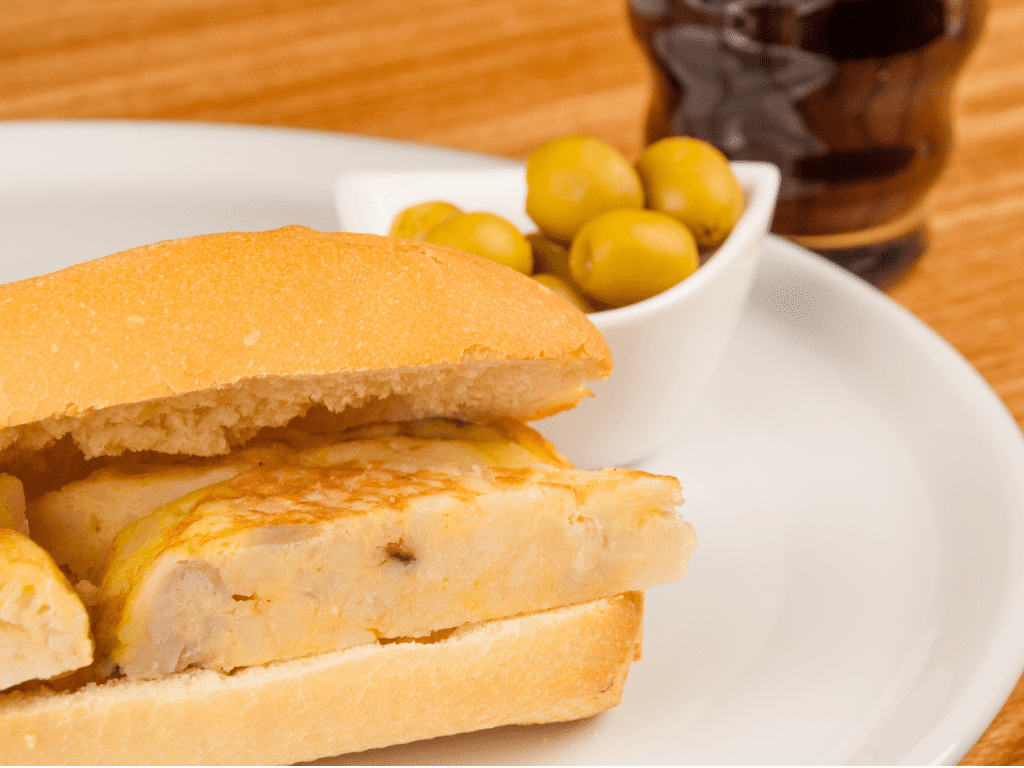
There are a few interesting things to note about lunch on the Camino.
First, breakfast and lunch seem to run together. Some days, I think I’d have three portions of tortilla de patata! I rarely had a technical “lunch.” I more or less grazed all morning.
Second, Spanish lunchtime starts around 2 pm! Sometimes, you are done walking by the time lunch rolls around. When you think of this this way, the morning grazing makes sense!
Here’s what to expect for lunch on the Camino:
- Bocadillo — The Spanish word for sandwich in Spain, bocadillos are long, baguette-like sandwiches. They often have the exact same ingredients you eat on your breakfast toast—jamón y queso (ham and cheese) or my personal favorite, tortilla! (Don’t knock it until you try it.) I did find more variety on the Camino Frances from Sarria to Santiago. For example, I had a yummy sardine and tomato sandwich in a garden!
- Tortilla — A piece of Spanish omelet with bread or other tapa (small bite).
- Drinks — Coke, water, sports drink, coffee, tea, cerveza sin (non alcoholic beer), wine, or beer.
Lunch on the Camino de Santiago usually costs $4-5 (€4-5) for a tapa or sandwich. Plus, you’ll need another coffee, soda, or sports drink to accompany it!
3. Dinner on the Camino

While lunch is the big meal of the day in Spain, dinner is the main meal when it comes to doing the Camino de Santiago.
After a long day’s walk, you’ll certainly be hungry! In addition, dinner is the perfect time to bond with fellow pilgrims. Be sure to invite someone to eat with you, or join a communal meal at your hostel.
Although Spanish restaurants don’t typically open until 8 pm (at the earlier), dinner starts around 6 pm at pilgrim restaurants and albergues.
For dinner along the Camino de Santiago, we recommend you order the pilgrim’s menu (menú del peregrino). For a fixed price, you will get a three-course meal consisting of your choice of an appetizer, entrée, and dessert. Bread and wine (unlimited) are also included!
Here’s what to expect on the Camino Pilgrim’s Menu:
- First Course: Soup, pasta, or salad.
- Second course: Pork chop, chicken breast, fish, or stewed meat served with french fries.
- Dessert: Yogurt, cheese, fruit, or fruit cocktail.
- Bread: Crusty white bread
- Drinks: Wine
Some pilgrims think the pilgrim’s menu is too much food. If that’s you, feel free to order a la carte. However, since food is pretty limited during the day, I prefer to fill my belly with fuel for the next day!
The pilgrim’s menu on the Camino costs around $11-13 (€10-12) per person. This 3-course meal is only served at dinner time.
Sadly, some pilgrims balk at the quality of the food and dismiss the pilgrim’s meal. Admittedly, the meals are more home-style than restaurant-style.
But, I’m grateful for a hot meal at the end of a long day. Truthfully, nothing sounds better. The simplicity of Spanish cooking, the kindness of Spanish hospitality, and Camino camaraderie is something I cherish.
Pilgrim’s Tip: Some stages have limited café stops. Thankfully, albergue hospitaleros (owners or hosts) will advise you if you need to pack snacks or extra water. Some even offer sandwiches to go. Always enquire to your host, other pilgrims, and consult your guidebook so that you know what to expect each day.
4. Drinks & Water on the Camino

When it comes to drinks on the Camino, first and foremost, don’t forget to drink plenty of water!
All along the route, there are water fountains with potable. Use them to fill up your water bottles. If you can’t find a fountain, ask at a café to have your water bottle filled.
Each night, fill up your bottles for the next day at your albergue. Kitchens/bars may not be open in the early morning hours to do so. (Even albergue kitchens may be locked.)
Aside from water, drinks — and finding people to enjoy them with — are a big part of the Camino experience.
At any time of day, you’ll be thirsty and need to rest. And where do you drink and rest: at cafés. Who do you sit with: fellow pilgrims.
Here’s what people usually order when it comes to drinking along the Camino:
- Coffee — Espresso drinks like café con leche, café cortado, or espresso solo.
- Tea — Chamomile is typical.
- Freshly-squeezed orange juice.
- Soda — Coke, Sprite, and Lemon Fanta, at least.
- Aquarius — Electrolyte drink similar to Gatorade.
- Wine — The house red wine is outstanding.
- Beer — Try local varieties like Estrella Galicia and Peregrina in Galicia.
Prices for drinks on the Camino are very reasonable from $1-3 (€1-3).
5. Snacks for the Camino

It’s a good idea to carry a few snacks with you on the trail in case you need some extra energy. In many of the towns (and certainly in the cities), there are small markets and grocery stores. Whenever you see one, pick up some things to nibble on.
Here are some ideas for snacks to carry with you:
- Nuts — Cashews, almonds, etc. readily available and provide healthy fats and protein, making them one of the best foods for hiking.
- Chocolate — This sweet treat offers a burst of energy and a little caffeine for a midday pick me up. Some people even like to bring chocolate covered espresso beans!
- Granola or energy bars — Bars provide a good mix of nutrients to fuel you. Just be sure to watch the sugar content.
- Fruit — Bananas, oranges, apples are a good source of fiber and natural sugars to bring your blood sugar up.
- Crackers — Crackers provide carbs and energy and are very easy to store and transport.
- Olives — Olives are easily accessible in Spain in little pouches. They are full of healthy fats that will help you stay fuller, longer.
- Dehydrated meats — You will find all sorts of cured meats in Spain. These are not only delicious, but provide protein.
- Yogurt — Yogurt is full of protein and is a good choice for breakfast. Just make sure you have a place to store it overnight, unless you don’t mind eating it at room temperature. I brought a spork with me for those days I was lucky enough to find yogurt.
Another plus is that groceries are relatively affordable in Spain. However, the prices are usually higher at the little markets along the Camino.
How to Save Money on Food on the Camino
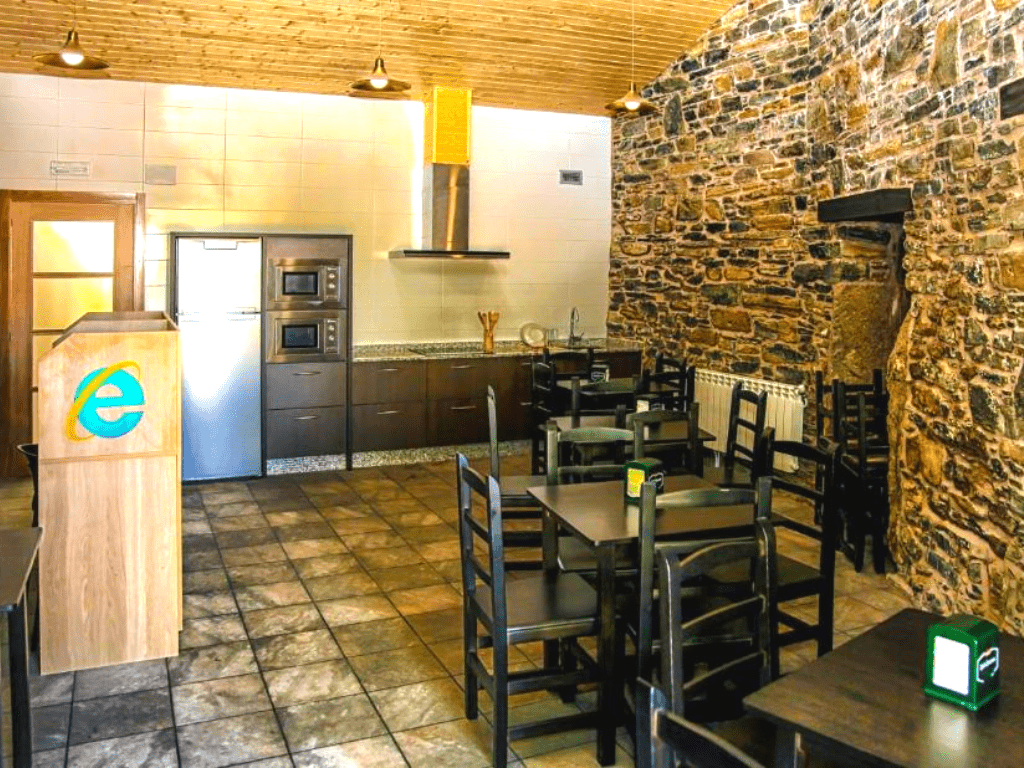
Although eating along the Camino de Santiago is relatively cheap, there are some ways you can save additional money if your budget is tight.
First off, forgo the drinks. Stick to the (free) water. Of course, you should buy something at cafés to use their restrooms and rest at their tables. So, do buy something, even if it’s a water bottle or soda to go.
Next, we’ve already mentioned above that you can buy snacks at grocery stores and markets. Technically, you can eat these for breakfast and even lunch, if you so desire. Bread, cheese, and sandwich meats are available if you’d like to make a picnic (although a small piece of tortilla de patata may actually be cheaper!)
When it comes to dinner, many albergues have shared kitchens available. Cooking your own food may save you some money on the Camino, especially if you split the cost with other pilgrims.
You might not even need to cook! For example, I put together some sandwiches and bought prepared salads (in the larger cities with actual grocery stores) a few times when I was too tired to wait for dinner to open.
Read more on what it costs to walk the Camino.
Top 5 Dishes to Try on the Camino de Santiago
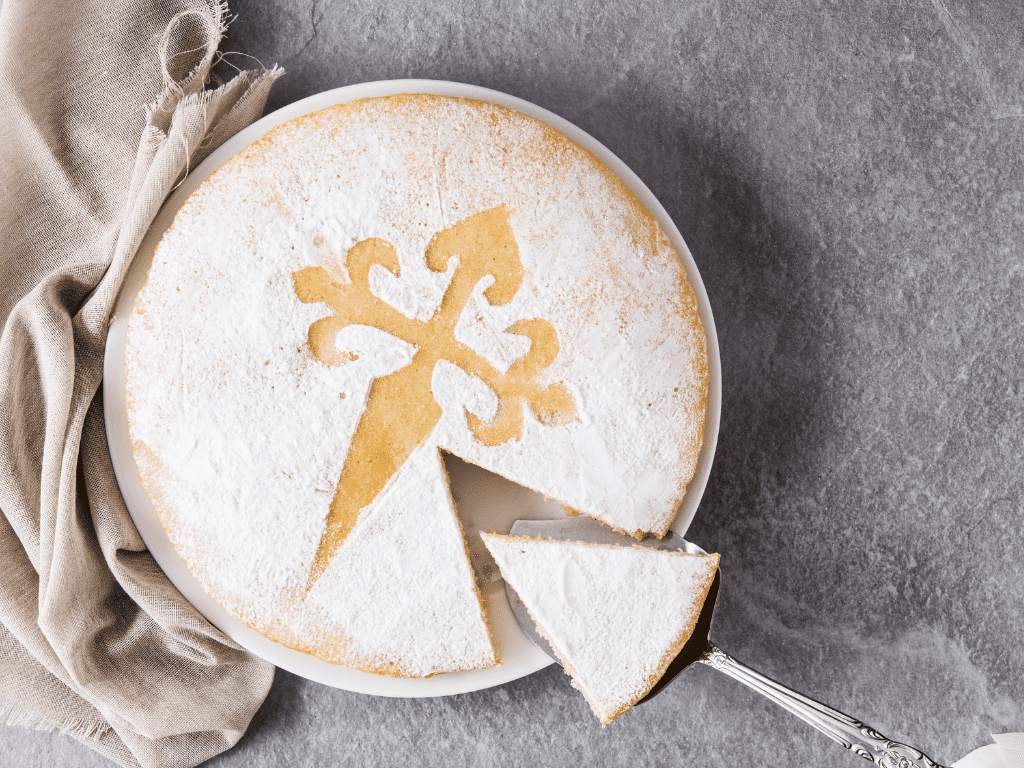
The food on the Camino de Santiago will vary from region to region. Therefore, there are certainly some things you don’t want to miss such as ice cream in Logroño, wine in Rioja, and pintxos (Basque-style tapas) along the Camino del Norte.
Once you hit Galicia, the region where Santiago de Compostela is located, here are some of the top dishes to try on your Camino:
- Caldo gallego (Galician soup) — This is a traditional Spanish soup with vegetables, greens, white beans, and sausage.
- Pulpo á feira (Galician Octopus) — Traditional steamed octopus sprinkled with paprika. The most famous place to eat pulpo is in Melide.
- Tarta de Santiago (Santiago cake) — As you near Santiago, you’ll find this gluten-free almond cake at many cafés. Enjoy for breakfast or as a snack throughout the day.
- Queso con membrillo — Local cheese and quince paste, usually served for dessert on the pilgrim’s menu.
- Pimientos de Padrón (Padrón Peppers) — Small, bright green peppers blistered and served as tapas. They are usually pretty mild, but you might catch a hotter one here or there!
Camino de Santiago Food FAQ
How much money should be allotted for food on the Camino de Santiago?
If you plan to eat out, you should plan to spend around $21 (€20) per person per day on food on the Camino de Santiago.
What time is each meal served?
When it comes to meal times, Spain has its own particular way of doing things. Meals are served (and only served) during these times:
-Breakfast — 7:30-10
-Lunch — starts as early as 1:30-3:30
-Dinner — starts as early as 8 pm until 11 pm
However, on the Camino, most restaurants cater to the pilgrim’s needs. For example, dinner often begins at 6pm for pilgrims. One pensión I stayed in Cacabelos even served food all
Can I drink a coffee before starting my walk?
If you leave early in the morning, before 7:30 am, there will not likely be anywhere open to drink a coffee before walking. You could either leave later or try to book a hotel that serves breakfast.
Will I find suitable food on the Camino if I am a vegetarian or vegan?
Vegetables are something every pilgrim misses from their diet, vegetarian or not! If you are vegetarian, the menú del peregrino usually includes a vegetarian option. Sometimes, you need to order two starters rather than a starter and a main. Salad (with tuna) and pasta are two staples for vegetarians. As long as you eat eggs and tuna, you will have no problems for breakfast or lunch. Vegans will have a little harder time. That being said, between Sarria and Santiago, there are more vegan and veggie-friendly options.
Final Thoughts on Eating on the Camino de Santiago
The Camino de Santiago truly is the journey of a lifetime. Along with lots of time for internal reflection and personal growth, the Camino offers a wealth of culture, history, and most importantly for the purposes of this article — food.
All in all, my best advice for you when it comes to eating on the Camino — when you see it, eat it. The cafés, bars, restaurants, and markets are more or less set up strategically for the benefit of the pilgrims. Trust that there will always be an open spot when you need it. Step inside, and order whatever is available. If you’re flexible and don’t mind a little monotony, you’ll do just fine.
Thank you for reading this blog on food on the Camino de Santiago, and I hope it will assist you in planning your own Way.
More Camino de Santiago Articles
You may be interested in these articles on the Camino de Santiago.
- Where Do You Stay on the Camino? A Guide to Albergues
- Ultimate Guide to the Camino de Santiago
- Camino de Santiago Packing List
Click image to pin to Pinterest!
